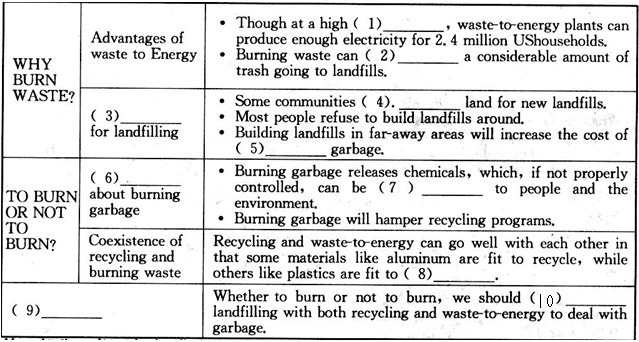阅读理解。
Waste to Energy-JUST BURN IT!
WHY BURN WASTE?
Waste-to-energy plants generate (产生) enough electricity to supply 2.4 million households in the US. But,
provrding electricity is not the major advantage of waste-to-energy plants. In fact, it costs more to generate
electrlcity at a waste-to-energy plant than it does at a coal, nuclear, or hydropower plant.
The maior advantage of burning waste is that it considerably reduces the amount of trash going to landfills.
The average American produces more than l,600 pounds of waste a year. If all this waste were landfilled, it
would take more than two cubic yards of landfill space. That's the volume of a box three feet long, three feet
wide, and six feet high. If that waste were burned, the ashes would fit into a box three feet long, three feet
wide, but only nine inches high!
Some communities in the Northeast may be running out of land for new landfills. And, since most people
don't want landfills in their backyards, it has become more difficult to obtain permits to build new landfms.
Taking the country as a whole, the United States has plenty of open space, of course, but it is expensive to
transport garbage a long distance to put it mto a landfill.
TO BURN OR NOT TO BURN?
Some people are concerned that burning garbage may harm the environment. Like coal plants, waste-to-
energy plants produce air pollution when the fuel is bumed to produce steam or electricity. Burning garbage
releases the chemicals and substances found in the waste. Some chemicals can be a threat to people, the
environment, or both, if they are not properly controlled.
Some critics of waste-to-energy plants are afraid that burning waste will hamper (妨碍, 阻碍) recycling
programs. If everyone sends their trash to a waste-to-energy plant, they say, there will be little motive to
recycle. Several states have considered or are cons idering banning waste-to-energy plants unless recycling
programs are in place. Massachusetts, New Jersey, and New York City have delayed new waste-to-energy
plants, hoping to increase the level of recycling first.
So, what's the real story? Can recycling and burning waste coexist? At first glance, recycling and waste-
to-energy seem to be at odds (不一致), but they can actually complement (弥补) each other. That's because
it makes good sense to recycle some materials, and better sense to burn others.
Let's look at aluminum, for example. Aluminum mineral is so expensive to mine that recycling aluminum
more than pays for itself. Burning it produces no energy. So clearly, aluminum is valuable to recycle and not
useful to burn.
Paper, on the other hand, can either be burned or recycled-it all depends on the price the used paper will
bring. Plastics are another matter. Because plastics are made from petroleum and natural gas, they are excellent
sources of energy for waste-to-energy plants. This is especially true since plastics are not as easy to recycle
as steel, aluminum, or paper.
Plastics almost always have to be hand sorted and making a product from recycled plastics may cost more
than making it from new materials.
To burn or not to burn is not really the question. We should use both recycling and waste-to-energy as
alternatives to landfilling.
Waste to Energy-JUST BURN IT!
